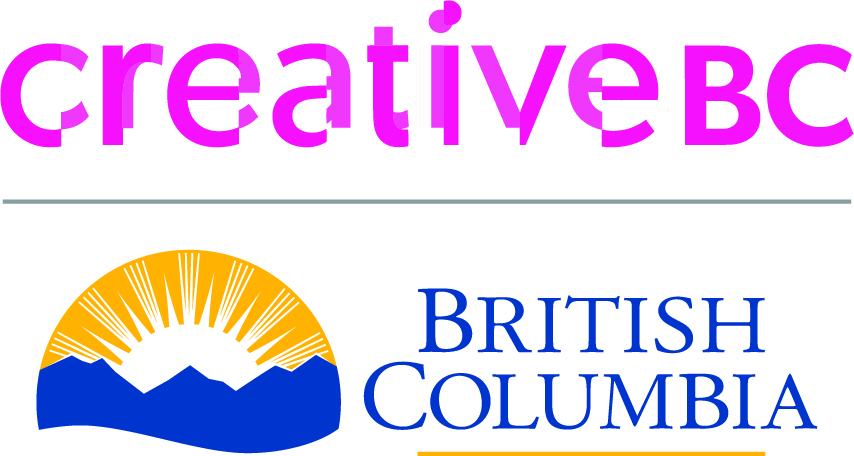It’s not everyday that you get to meet a celebrity, let alone one who’s so humble and down-to-earth. Simon Oxley may not be a household name (yet!) but you definitely know his work. He designed the original Twitter bird, GitHub’s Octocat, the Bitly puffer fish and iStockphoto.com’s former logo, to name but a few. And, if you’ve been to Spark Animation or Spark FX, you’ve likely seen his beautiful whimsical work in our conference poster designs.
A brilliantly talented, lovely human being, Simon sat down with us to chat about his artistic path, creative inspiration, and the world in between.
What first got you started in the arts? Can you tell us a bit about your background?
Firstly, thank you for choosing to interview me, big privilege to be in such good company.
As a youngster, I was a big fan of graphic novels, comics and illustrated story books — I enjoyed tracing the images and creating my own — my friends also drew, so there was an element of polite competition involved — I took this interest through school by adding illustrations to my class work such as history and geography, for which I gained ‘House Points’, awarded for the drawing, not the written work.
From school, I attended a year-long foundation course in drawing and study of old masters from all periods in history, visiting London art museums, and studying photography including dark room processing of film.
I then moved out of my parents home and travelled to Bournemouth, where I attended the graphic design and illustration course for 2 years — we were introduced to many aspects of design and how design can impact people’s lives in general — we were lucky to have incredibly accomplished guest lecturers from leading London ad agencies, logo designers such as Saul Bass, and a Vietnam war photographer called Tim Page.
Upon completion of the course, I entered the job market working within an early video game company, making the inserts for cassettes — cutting type and arranging it with hot wax — artworking.
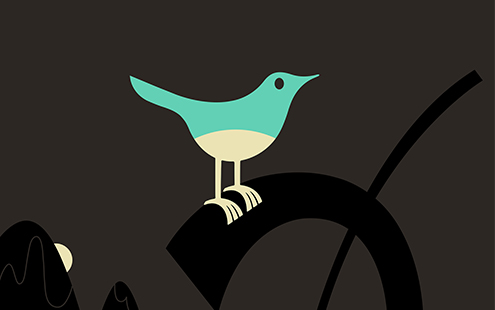
I am oblivious to the journey my illustrative style has taken — I did live in Japan, where cute characters and not so cute Yōkai are prevalent in all areas of life there — my children were babies so I would watch the NHK shows each morning at breakfast with them, always impressed, not only with the styles, but the deep meanings and storytelling aspects within their scenarios.
I enjoy viewing all styles of imagery made by other people — while pursuing a never ending search for distinctive bold coloured icons over detailed illustrations.
I have carved out a niche, it seems, in so much as clients tend to approach me with mascot requirements — I enjoy these projects, because the work doesn’t involve lots of detail and room for committee-driven decision-making.
What’s your creative process?
I begin by drawing pencil sketches, and making notes — once I have a varied selection, I send them to the client — from there, the chosen direction can usually be found and honed to completion — it’s a very relaxed working style, which allows for sudden changes in direction — ultimately, I always want the client and their team to be surprised and happy, working on something which is often lighter than their core business focus.
Where do you find inspiration for your art?
Watching old samurai films such as Zatoichi: The Blind Swordsman — seeing the ideas and designs my 2 kidults, Tyler and Hagen make — my eldest 18yrs, is particularly keen on arts and design, choosing it as part of his 6th form curriculum. I also upload to Dribbble.com/simonox — this platform has introduced me to many incredibly talented designers based all around the world, so it is fun and intriguing to see what people from various cultures produce each day.
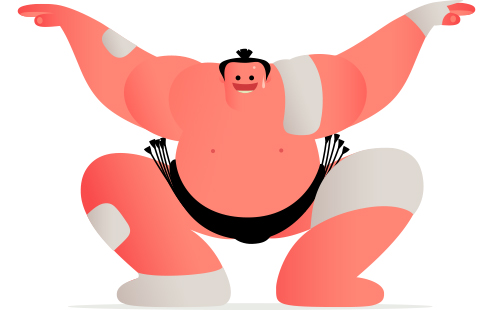
There’s lovely variety in your designs: flat 2D, use of gradients, line art, and more. Do you have a preferred design æsthetic? And, what informs your choice of which method to employ?
Often, I tend to make images in a style which excites me that day — then, it goes somewhere, and I may spend further days applying the style to any ideas which arrive — then, on another day, I will produce in an alternative style, this keeps life interesting, while broadening my offering, to an extent.
I see that you lived in Bahrain as well as Japan, for a number of years, before returning to the UK. What informed those moves, and how did those experiences influence you and your art?
I have held a fascination in foreign cultures for a long time and always wanted to combine travel with my creative endeavours — I applied for an Australian passport, which took too long to process, I was spending all my money, so I decided to visit Thailand, being my chosen stopover to Australia — I spent a month there and met my Japanese wife, Noriko. I returned to the UK, spoke with a recruitment agent based in London and expressed an interest in working in Hong Kong — she didn’t have anything on her books for the Far East, but did have on in Bahrain — I met the owner of the company and was interviewed for the Art Director role, which I accepted and landed there a week later. It was a great experience, meeting people from all over the world, while enjoying the heat of the summers, 50 degrees often.
While in Bahrain, I kept up steady correspondence with Noriko who was still Japan-based. A friend in Bahrain told me about his brother, who owned a multimedia web design studio based in Harajuku, Tokyo, so I went and arranged to meet him. He offered me a position with no real title, I ended up designing Annual Reports for many well-known Japanese Corporations. This was a great opportunity to visit offices around the country by plane and bullet train. I accompanied our Japanese client, and we would often find ourselves a bit tipsy in Karaoke bars in the evenings after company visits. The next morning’s meetings were a joy to deal with.
You designed the original Twitter bird, GitHub’s Octocat, the Bitly puffer fish and iStockphoto.com’s former logo. An impressive list, and yet you remain so humble! I was sad to hear though, that you didn’t really get to enjoy much direct financial gain from many of those contributions. That being said, how did that exposure affect or influence your career?
Those jobs gave me the best exposure a designer could hope to gain — to be perfectly honest, I only require a few jobs per year to cover outgoings and save a bit, so there are no hard feelings felt over an apparent underpayment of any kind.
As a master in the field, what constitutes good mascot design in your opinion?
This is a tricky question, since each character must represent unique qualities of the business it represents — I guess something which has impact, some memorable qualities.
What can you tell us about your designs for the Spark festivals and conferences?
I worked with a Dublin-based designer, Gerard Whelan, supplying him with characters I had already created and offered Royalty Free. He then arranged them to make the word ‘Spark’ and create t-shirts, etc using details from the core image.
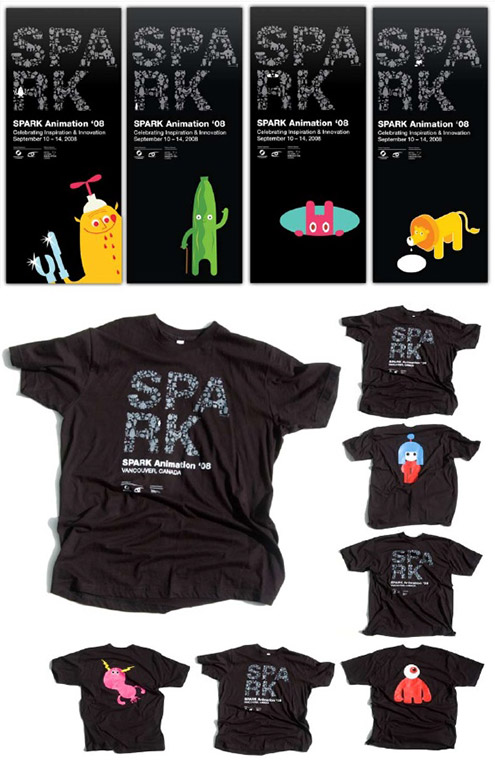
Update from Spark’s founder: Simon’s too humble to say it, but he did far more than just work with Gerard and supply us with his art. He worked with us quite closely and was a pleasure to collaborate with. Because of time and budget constraints, it’s true, at first he gave us access to his catalog for SPARK FX 2008 and SPARK ANIMATION 2008, but he also did original work for SPARK FX 2009 and SPARK ANIMATION 2009. We also used his images from iStockphoto for our first animation festival. And a fun anecdote, we started working together as a result of our burgeoning creative friendship. A designer myself, I would send him copies of the work that I was creating using his stock illustrations, and he started sending me postcards that he designed. The relationship evolved from there :)
Is there a project that holds a special place in your heart or that you’re most proud of?
I recently made ‘Pulumipus’ for Pulumi.com, a Seattle-based tech firm. Working closely with Joe Duffy, a tech guru for many in the broader tech field — I was worried initially, whether I could draw a good platypus, but once I was in the flow, I managed to arrive at vivid coloured poses which represented the various aspects of their offering.
Hoss.com was a good client — again in the tech field, Austin Texas-based startup founded by accomplished people in the tech arena. And most recently, Maggie Louie, founder of Devcon, DevDirect, found me drawing both an Otter and Axolotle — she is great fun to work with, we shared time on Zoom and got to know each other a little while laughing at shared experiences, both 50yr olds.
You’re most well known as a mascot designer and graphic designer, but I see that you also work/play in clay. What brought on that interest and what kind of projects do you work on?
Making things using DAS clay has long been an interest — I am eager to see the characters in real life which is the driving force behind those — they are all made for personal enjoyment, allowing time away from the constrictions of the computer screen.
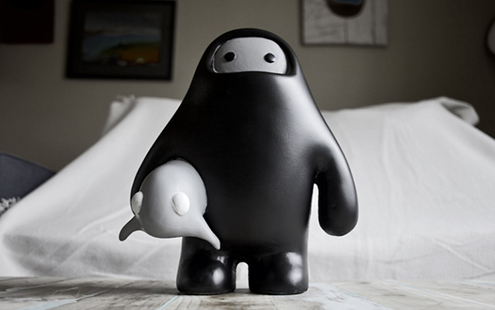
Have you ever worked as an employee, or have you always freelanced?
I was lucky to be able to follow a freelance path after having worked as an employee alongside very inspiring, talented people from various disciplines such as coding, space travel as well as marketeers and other management folks. So, I gained a lot of appreciation for both creative and underlying business reasons to produce.
While at Incentive Media, a Tokyo-based web design company, I was lucky enough to meet with Japanese astronaut, Dr Mohri — he had traveled to space on the Space Shuttle, where his mission was to photograph earth. As of 2007, Mohri is the Executive Director for the Miraikan, the National Museum of Emerging Science and Innovation in Tokyo. I designed slides, which were used during his opening speech, and enjoyed a personal tour of the Museum with Dr Mohri, who showed me his watch, which he had worn in space.
The CEO of Incentive Media was an Australian national, Geoff Dossor, who was also the best man at my wedding in Fukuoka. It was a traditional ceremony which took place in the sweaty month of August 2000 — I was dressed in the traditional Haori Hakama wrapped tightly by three Japanese elderly ladies.
What was your greatest challenge in transitioning to freelance?
Working solo means I can only do one project at a time, so it is vital that I communicate daily with clients who are in various time zones — this means occasionally speaking through video call late at night GMT. I have been lucky to receive a steady stream of contracts, which haven’t often overlapped.
Any advice to promising young designers looking to make their mark?
Be yourself, try things out, be bold, have a clear price in your mind to give potential clients if you are doing this for money.
What are you currently working on?
I have a few mascot jobs in the pipeline and need to schedule them so they do not occupy my mind all at once — I like to do one task at a time and give the clients the benefit of my full attention.
Is there a dream project that you’d like to work on? Or a company you’re dying to collaborate with?
I don’t have a specific dream job, I enjoy the projects I am working on — meet some very generous good people mostly through the internet, over face-to-face meet-ups — perhaps, once my children have flown the nest and global pandemics have disappeared, I will venture off to visit new and previously visited climes with my wife and kids, if they want.
That said, I would like to work on an animated film/movie, developing a cast of characters and worlds they inhabit while leaving the technical animating to the experts — it would be nice to see the characters on people’s clothing and accessories. Although saying this, I am currently happy to experiment with ideas, which may answer a potential client’s wishes, which is sometimes the best way to work — like a fine artist who makes and then sells — not to order.
And I have to ask — after happening upon “No Not Yeti,” “Platysage,” “Shut Up & Follow Me,” and “Small Unemployed Mascot,” I found myself endlessly scrolling through your Dribbble account for the added joy of seeing what other clever titles you came up with. Are you a natural pun-master? Or, is your hilarious dry humour an acquired skill?
My humour is dry as a bone — I do enjoy the combination of words and pictures, believing that chemistry deepens the communication of character and attitude — I am very happy to hear you shared the jokes and hope many do, this should remain a fun diversion for all — drawing and ideas are, after all, an inclusive past-time anyone can apply their unique personality to.
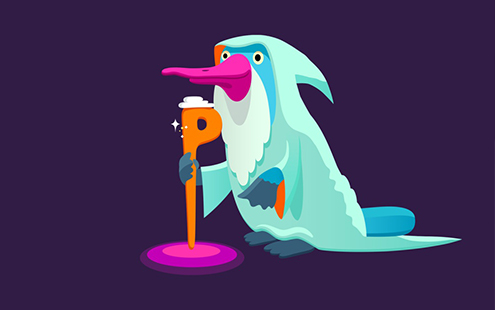
Thank you so much Simon, for taking the time to chat with us!
If we’ve piqued your interest, and you’re keen to know more, you can check out more of Simon’s work here: https://dribbble.com/simonox (be sure to read the image captions — you won’t be disappointed).
